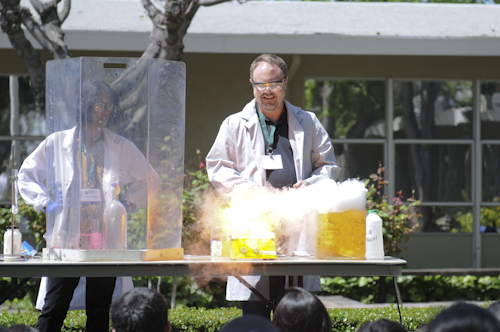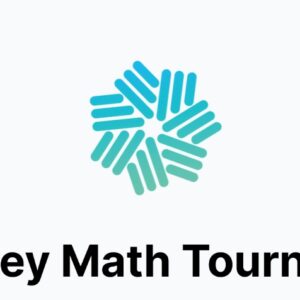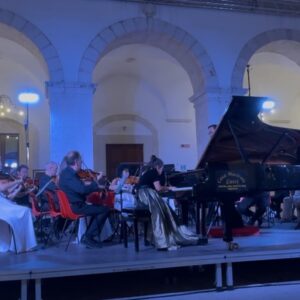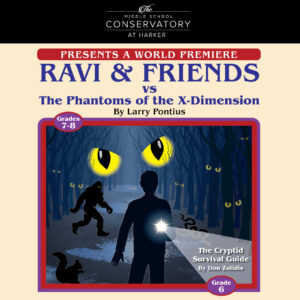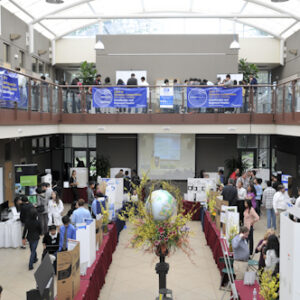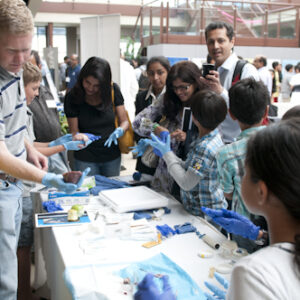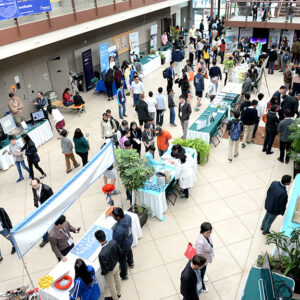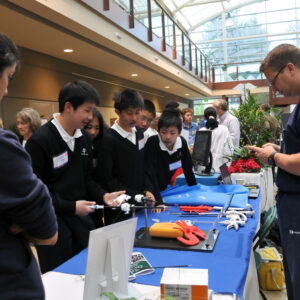Harker’s eighth annual Research Symposium drew more than 400 attendees, who marveled at the many exhibits, student presentations, breakout sessions and guest speakers that have made the symposium into one of the school’s signature events, unique for being organized largely by the student-run WiSTEM, chemistry, research and Sci Fy clubs.
The upper school campus was abuzz with activity as early as 8 a.m., when the symposium officially began. One of the busiest areas for the entire day was the Nichols Hall atrium and rotunda, where exhibitors such as Google, Ericsson and Symmetricom offered demonstrations of their products and talked with attendees, in addition to providing a mere glimpse at the wealth of career opportunities available to students of the sciences.
One of the more impressive pieces of technology on display was Anatomage’s “virtual cadaver,” a 3-D rendering of a human body that could be examined in amazing detail via a large touch screen, enabling classrooms without access to a real cadaver to study the human body up close.
Elsewhere in the atrium, SeaLife Aquarium Maintenance presented various sea creatures for visitors to view and handle. East Bay Cardiovascular and Thoracic Associates, represented by Harker parent Murali Duran (Rohan, grade 9; Lea, grade 11; Roshan, grade 12), had a heart station set up where visitors could learn how to perform sutures using store-bought pig hearts.
A large portion of the event was devoted to formal talks, also known as breakout sessions, delivered by Harker students. In these talks, students gave presentations on scientific research projects that they had done, many of which earned the students finalist or semifinalist placings in the Siemens Competition and the Intel Science Talent Search. In addition to demonstrating the high level of research being conducted by the students, these sessions also offered students the chance to show their research to (and take questions from) members of the greater scientific community.
The breakout sessions covered a wide variety of topics. Ashvin Swaminathan, grade 12, presented an analysis of surreal numbers, for which he was named an Intel Science Talent Search semifinalist and a Siemens Competition regional finalist. At another session, senior Rohan Chandra, another Siemens regional finalist, discussed the brain’s reaction to various features of Beethoven’s famous fifth symphony. Meanwhile, Siemens semifinalists Anika Gupta and Saachi Jain, both grade 11, presented their research on how an uncharacterized gene may have a hand in lowering the risk of ulcers and gastric cancer.
Middle school students also had their chance to shine, showing the results of their work with the many impressive poster presentations set up in the gym. The enthusiasm of these students was evident as they explained their projects and their implications to the fascinated passersby.
As always, the lunchtime chemistry magic show was a treat for the midday audience, who oohed and aahed at brilliant flames, exploding eggs, liquid-carbon-frozen bananas and other wonders of chemistry, as they enjoyed food freshly prepared by Harker’s kitchen staff.
Also during lunch was a special talk by Nikita Sinha ’09, currently in her senior year at the California Institute of Technology, who discussed the research she was conducting for her senior thesis, as well as the life experiences that led her to choose medical research as a career.
The first of the keynote speakers at the symposium was Dr. Kristian Hargadon, assistant professor of biology at Hampden-Sydney College. Hargadon took the morning audience on a journey through his progression from a young student athlete with dreams of being an NBA star to becoming a decorated cancer researcher, in addition to discussing some of his current work.
Surbhi Sarna ’03, this year’s alumni speaker, shared her story with the early afternoon audience. After suffering from an ovarian cyst in her early teens, Sarna became determined to create better conditions in the field of female health. Toward this end, she founded the venture-backed nVision Medical in 2009 to develop technology that will help gynecologists more quickly detect ovarian cancer.
This year’s featured speaker was Nobel Prize-winning biologist Dr. David Baltimore, whose work at the California Institute at Technology has recently yielded a method for preventing the spread of HIV. Baltimore provided an overview of how his process of injecting a harmless virus containing antibodies into the muscles of mice prevented HIV infection. Baltimore and his team are currently preparing to test this process in humans.
Another highlight of the event was a special panel of notable women in STEM (science, technology, engineering and mathematics), which included such inspirational figures as Barbara Jones, project manager at the IBM Almaden Research Center; Monica Kumar, senior director of product marketing at Oracle; Tian Zhang, senior software engineer at IBM; and alumna Sinha.
The panel discussed the increasingly important role of women in the sciences, offering their insights into their respective fields as well as advice to the audience of young attendees on how to transform their love of science into successful careers.
The symposium closed with a panel of students and teachers providing students and parents with information on Harker’s research program and the various opportunities available, such as the Siemens and Intel contests, internships and research classes.
